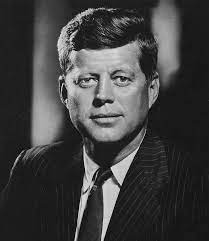
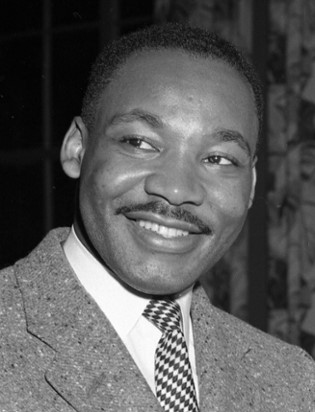
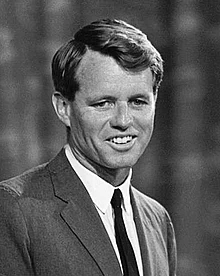 There are good reasons to think that the KGB arranged the murders of John F. Kennedy, Martin Luther King, and Robert F. Kennedy, as well as of other Americans. Note: “good reasons”, not definitive proof. In each case, I will argue that We must consider the KGB the leading suspect (in the JFK assassination, a KGB rogue and the Mafia collaborated while the KGB acted as a ghost partner). This perception can guide further investigation that can result in the more definitive finding that the KGB arranged these and related murders.
There are good reasons to think that the KGB arranged the murders of John F. Kennedy, Martin Luther King, and Robert F. Kennedy, as well as of other Americans. Note: “good reasons”, not definitive proof. In each case, I will argue that We must consider the KGB the leading suspect (in the JFK assassination, a KGB rogue and the Mafia collaborated while the KGB acted as a ghost partner). This perception can guide further investigation that can result in the more definitive finding that the KGB arranged these and related murders.
First, I will explain how the KGB and Mafia have emerged as the prime suspects in the JFK assassination. Not only was this the most important and best-known case. New evidence and interpretation point to the KGB’s role in particular and have implications for the other murders. Second, I will treat each of ten likely KGB murders in summary fashion. Third, I will touch on factors that have hampered resolution of these cases for many decades. Fourth, comparing the cases, I will identify characteristics of the KGB’s art of deniable murder. Fifth, I will draw some conclusions.
*****
1. The KGB and JFK
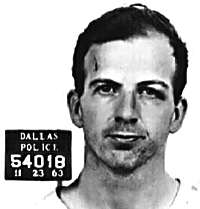 New evidence and analysis suggest that the KGB was behind the 1963 assassination of President John F. Kennedy.
New evidence and analysis suggest that the KGB was behind the 1963 assassination of President John F. Kennedy.Some observers have always considered the Soviets a likely suspect. Lyndon Johnson evidently did. According to the House Select Committee on Assassinations’ chief counsel, Robert Blakey, after the assassination the Soviets went on nuclear alert. Johnson assured the Soviets that the US had no evidence of Soviet involvement and planned no reprisals.32 He also ordered the suppression of any hint of a KGB conspiracy for fear that an outraged public would demand retaliation that would lead to war.33 The Soviets had a palpable, powerful motive for assassinating Kennedy: to gain revenge for the humiliation of Khrushchev and the USSR in the 1962 Cuban missile crisis. The assassination also removed a popular young president and demoralized many Americans, while the cover-up alienated them from their government and media.
Certainly, the idiosyncratic odyssey of Lee Harvey Oswald into the Soviet Union and a Russian marriage as well as his contacts with Soviet diplomatic offices preceding the assassination afforded the KGB many opportunities to interact with him. Thus the KGB is the elephant in the living room of suspects in this case. Yet repeated investigations have failed to turn up specific evidence that would implicate the KGB.
The Mary Meyer Story
Now a new report (“Did the KGB Murder President Kennedy’s Girlfriend?”) explains how the KGB used a contract killer to murder Mary Pinchot Meyer, a JFK consort during his White House years, on the Canal towpath near Georgetown. Her murder is linked to JFK’s.
Three aspects of the Meyer case deserve consideration.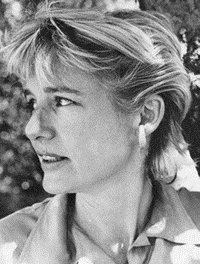
First, the KGB must have had a compelling reason to murder Mary Pinchot Meyer. Otherwise, it is hard to see why they would have taken the risk of exposure. The most plausible motive would have been to get revenge against Meyer for misleading Khrushchev and the KGB about Kennedy (she was acting as a behind-the-scenes intermediary between Kennedy and Khrushchev, with an apparent personal agenda of promoting peace via marijuana- and LSD-induced softening of American and Soviet leaders).34
According to Ion Mihai Pacepa, at the time deputy director of foreign intelligence for Gheorghe-Dej’s Romania, in his book Programmed to Kill: Lee Harvey Oswald, the Soviet KGB, and the Kennedy Assassination35, Dej was visiting Moscow at the time of the Cuban Missile Crisis. Pacepa writes:
“According to Dej’s account, when Khrushchev finished reading that cable [from the KGB in Washington saying that Kennedy had ordered a naval quarantine of Cuba], his face was purple. He looked inquiringly at [KGB chief] Semichastny, and, when the terrified general nodded, Khrushchev ‘cursed like a bargeman’. Then he threw Semichastny’s cable on the floor and ground his heel into it. ‘That’s how I’m going to crush that viper,’ he cried. The ‘viper,’ Dej explained in telling the story, was Kennedy.
Goading himself on, Khrushchev grew increasingly hysterical, uttering violent threats against the ‘millionaire’s whore’ and his CIA masters.”
Dej interpreted ‘that viper’ and the ‘millionaire’s whore’ as references to Kennedy, but viper (gadyuka) is feminine in Russian and a common epithet for a malicious, treacherous woman. Moreover, Kennedy was a millionaire himself and of the wrong gender, and he did not have CIA masters. A far better interpretation is that Khrushchev was referring to Mary Meyer. In turn, this suggests that Meyer’s peace rhetoric and her talk about the purported use of drugs by American leaders had emboldened Khrushchev to undertake his breathtakingly reckless Cuban missile adventure, which ultimately led to a deeply embarrassing withdrawal. However, the close fit with Meyer did not mean that Khrushchev was not after Kennedy; rather, it showed that he was eager for vengeance, and that would clearly include Kennedy as well.
Second, Meyer’s murder occurred not several years before or after the JFK assassination, but 11 months after—enough time for it not to seem too closely connected, but not any more time than that.
Third, the divorced husband of Meyer was senior CIA official Cord Meyer. When questioned by a reporter as he neared death in 2001, he said that his ex-wife was murdered by “[t]he same sons of bitches that killed John F. Kennedy.”36 This statement has been taken to refer to the CIA, but that makes no sense. There is no good reason to think that CIA was involved in the murder of Kennedy, despite strained efforts by some observers (and Soviet disinformation) to suggest otherwise. Nor is there any valid reason to think that the CIA wanted to murder Mary Pinchot Meyer, who was a long-standing friend of Agency officials. (This has not stopped some from suggesting that CIA murdered her to cover up its assassination of Kennedy.37) Lastly, Cord Meyer is not likely to have referred to his ex-colleagues in those terms, and he himself was serving in CIA during the assassination of Kennedy.
But, if one assumes that CIA knew that the KGB had murdered Mary Pinchot Meyer, then Cord Meyer’s remark takes on a very different meaning. It is a statement by a former senior CIA official that he, and presumably the Agency in general, had concluded that the KGB was behind the murder of John F. Kennedy.
The KGB’s Favorite U.S. Marine
The Soviets repeatedly denied that the KGB had had any contact with Lee Harvey Oswald, and at first they were suspicious of him. But as a Marine radar specialist in Japan and California, Oswald had access to extensive classified information regarding radars, flight patterns, and in particular the new height-finding radar that would have been of exceptional interest to the KGB in regard to the U-2 spy flights. Oswald told US Embassy officials in Moscow that he intended to reveal sensitive information to the Soviets. Gary Powers, pilot of the U-2 flight downed in May, 1960, suggested that Oswald betrayed to the Soviets information that they used to shoot down the U-2.38 This seems very believable, and it would mean that Oswald had proved himself a loyal communist and one who had provided precious information to the USSR. So the KGB came to trust him.
Given Oswald’s aggressive mentality and track record (well known to the KGB), it would have required very little for the KGB, without specifically stating its/Khrushchev’s wish, to insert into his mind the suggestion that he assassinate an American president. Virulent communist hate propaganda during Oswald’s years in the Soviet Union might have instilled in his impressionable brain the need to take action, as the occasion presented itself, against those like the American president who thwarted the progress of communism.
According to Pacepa, there are reasons to think that, under cover of a civilian life in Minsk, Oswald received KGB training in clandestine techniques for serving as an operative if and when he returned to the United States. The KGB provided Oswald his wife Marina according to a standard technique to bind a foreign agent to the USSR.
Defector Yurii Nosenko’s denial of KGB interest in Oswald, Pacepa points out, was incorrect because Nosenko was in the domestic division of the KGB and was not aware of the interest of the foreign branch (PGU) in him. This explanation trumps standard Lone Gunman accounts by authors who have convincingly debunked many conspiracy theories but have themselves mistakenly followed Nosenko.39 Pacepa also argues that, even though the Soviets originally may have had the intention of assassinating Kennedy, in 1962 the KGB ordered its agents worldwide to cease assassination activities because Khrushchev’s reputation had been badly tarnished as an orderer of assassinations in a West German criminal case. Failing to receive a go-ahead from the KGB, Oswald went rogue. He purchased a rifle on his own, against KGB practice, and pursued his own plan to assassinate Kennedy. The KGB was alarmed enough to move Oswald’s handler (George de Mohrenschildt) out of Dallas in April, 1963 and into sequestration in Haiti. But the Soviets, now with the added motive of avenging the humiliation of the Cuban Missile Crisis, evidently decided not to stop Oswald or warn the Americans.
Therefore, following the incisive account of General Pacepa, the most senior Soviet Bloc intelligence officer to defect during the Cold War, the answer to the question of whether the Soviets ordered Oswald to assassinate Kennedy appears to be No. But they provided the ugly, suggestive propaganda that led Oswald to hate Kennedy; they trained him as an operative, including with rifle practice;40 they provided him a masterful KGB handler (de Mohrenschildt); they failed to do whatever necessary to cause him to desist; and they deliberately neglected to warn the Americans of a likely upcoming assassination attempt. The KGB also appears to have ordered Cuban intelligence asset Jack Ruby to murder Oswald in the event that he succeeded in assassinating Kennedy, Pacepa argues; and (Pacepa also suggests) the KGB killed Ruby himself with radioactive poison at the time when he was scheduled for retrial and would become available to talk with reporters.
The contract murder of Mary Meyer would make a third KGB-arranged killing that fit into the pattern of doing away with problematical individuals connected with Kennedy and/or his assassination.
Thus, even though Oswald ultimately acted on his own, the KGB was deeply involved in the assassination of John F. Kennedy and must share the blame for it, as must Khrushchev.
Still, we have to account for the presence of the Mafia around the assassination, as well as for the high number of suspicious deaths of those involved. Oswald may have received a suggestion that someone should remove Kennedy indirectly from Nikita Khrushchev, whom Oswald held in great respect and termed “simply brilliant”. When the exposure in a West German court as an orderer of assassinations led Khrushchev to halt murders in 1962, Oswald pushed on, perhaps assuming that Soviet bureaucrats were blocking Khrushchev’s true desire to eliminate Kennedy.
Oswald appears to have persuaded his uncle, Charles Murret, to induce his boss, New Orleans Mafia kingpin Carlos Marcello, to provide a professional sniper. Marcello held a powerful grudge against the Kennedys for publicly humiliating him by roughly deporting him to Guatemala. Marcello and other organized crime leaders were also threatened by Attorney General Robert F. Kennedy’s crusade against them; killing his older brother would neutralize RFK. With KGB training, Oswald himself had become an excellent shot; but he was shooting from a bad angle and far to the rear. The Mafia’s professional sniper on the nearby grassy knoll fired the killing shot from the front, knocking off a chunk of Kennedy’s skull and pieces of his brain. Thus Oswald, who planned the shooting and likely participated in it, could plead in court that he was the patsy. In fact, Oswald told journalists after the assassination “I’m just a patsy.”41
Meanwhile, Oswald’s deliberately misleading dealings with anti-Castro and pro-Castro Cubans, FBI, and CIA-connected individuals caused further confusion. So did the destruction of evidence and stonewalling by U.S. Government agencies covering up their mistakes after the assassination as well as by the Kennedy family seeking to protect JFK’s reputation.
So the KGB was involved with both gunmen: Oswald was a KGB-recruited and trained asset who turned rogue and served as the patsy, while Oswald himself arranged for the Mafia sniper. Thus this is a KGB-Mafia theory of the case, with a KGB rogue dealing directly with the Mafia, and the KGB itself working in the background even after breaking off contact with Oswald. It spread rumors, activated a well-prepared Second Oswald imposter, and ordered Jack Ruby to murder Oswald to shut him up after the assassination of JFK. The roles of Meyer and de Mohrenschildt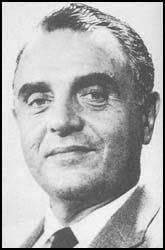 (whom Pacepa persuasively identifies as Oswald’s KGB handler42) powerfully support this KGB rogue/ghost KGB interpretation. Many researchers have mistakenly labeled de Mohrenschildt a CIA asset, but his assiduous consorting with CIA was clearly his cover and a means of spreading disinformation.
(whom Pacepa persuasively identifies as Oswald’s KGB handler42) powerfully support this KGB rogue/ghost KGB interpretation. Many researchers have mistakenly labeled de Mohrenschildt a CIA asset, but his assiduous consorting with CIA was clearly his cover and a means of spreading disinformation.
Adding the Mary Meyer story and the Mafia role to Pacepa’s telling account gives us an explanation of the JFK assassination that contains both the idiosyncrasies of Oswald and the deceptive maneuvering of a KGB engaged in its specialty of deniable murder, with a fistful of motives including exacting revenge for the humiliation of the Cuban Missile Crisis. The Kennedy assassination and related murders can be seen as an integral episode of a Cold War that America waged against a ruthless enemy.
*****
2. Ten Murders
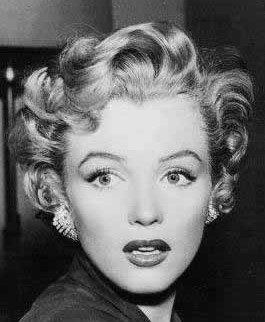 August 4, 1962. Celebrity actress Marilyn Monroe died in her bedroom in Los Angeles (or in the guest house near her house, from which she was carried back to her bedroom).43 The autopsy found a bruise on her hip indicative of violence, and she had taken in a very high dose of drugs; yet there was no residue in her stomach nor glass for water to take pills. Bruising around her colon led to suspicion that she had been chloroformed, then dosed lethal drugs with a bulb syringe. Lividity marks showed that her body had been moved. Someone broke into the safe containing her files, and the files were gone. Although the first police at the scene, some eight hours after death, suspected murder, there was no formal police investigation. The media reported the autopsy finding of suicide (penciled in as Probable Suicide).
August 4, 1962. Celebrity actress Marilyn Monroe died in her bedroom in Los Angeles (or in the guest house near her house, from which she was carried back to her bedroom).43 The autopsy found a bruise on her hip indicative of violence, and she had taken in a very high dose of drugs; yet there was no residue in her stomach nor glass for water to take pills. Bruising around her colon led to suspicion that she had been chloroformed, then dosed lethal drugs with a bulb syringe. Lividity marks showed that her body had been moved. Someone broke into the safe containing her files, and the files were gone. Although the first police at the scene, some eight hours after death, suspected murder, there was no formal police investigation. The media reported the autopsy finding of suicide (penciled in as Probable Suicide).
Monroe had a long-time, friendly relationship with the Chicago Mafia. She also befriended Frederick Vanderbilt Fields, a well-known leftist with communist ties. Earlier in 1962 she had had a brief fling with President Kennedy, and then a longer romance with Attorney General Robert Kennedy, married father of seven. Many witnesses have said that he was in Los Angeles on August 4. Coming to her home in the afternoon, he had quarreled with her, then left. That night he abruptly flew back to Washington, D.C. Various authors have accused him of arranging her murder, to cover up her affairs with the Kennedys and any damaging information about them that she might reveal to journalists. But this would have been extremely risky. Observers have also noted that the Kennedys were not in the habit of murdering ex-girlfriends. Journalists had never reported John Kennedy’s many other infidelities.
The other main suspect has been the Mafia, seeking to collect dirt on the Kennedys and to cast suspicion on them, in revenge for double-crossing and oppressing organized crime, which had helped JFK win Illinois and West Virginia in 1960. But murdering Monroe would run against her friendly Mafia ties going back to her early days in Hollywood.
Although the KGB has not attracted suspicion, there are good reasons to suspect that it was the real perpetrator. As part of its ordinary business, the KGB would have tracked gossip and the activities of the two Kennedys. It could have planted the listening devices found later and added the extra tap found on her phone line (besides the FBI one), or inserted an informant into her entourage. The KGB had palpable motives: to cast suspicion on both Kennedys, to spread scandal about them, to collect information to use in blackmailing them, and to demoralize Americans by killing an iconic American celebrity while smearing her reputation. Intruding into a fraught situation was a characteristic KGB move.
Another such move was to use medical treatments to undermine a target person (compare the treatment of George de Mohrenschildt below). Monroe’s physician, Hyman Engelberg MD, gave her unusually frequent injections of drugs and prescribed excessive amounts of tablets as well, while her psychiatrist, Ralph Greenson MD, engaged in long consultations with her that led to her psychological dependence on him and to emotional instability. We must suspect that, using threats or financial inducement, the KGB had suborned the doctors into bringing Monroe to the brink of collapse.
Several KGB hit men seem to have broken Monroe’s bedroom window, chloroformed her, warned her housekeeper to keep quiet, administered a lethal dose of drugs, moved her body, perhaps even to the guest house, removed bugs, broke into her safe in the guest house to steal her files, with possible defamatory information about the Kennedys, and departed. Then psychiatrist Greenson, phoned by housekeeper Eunice Williams, arrived and supervised a surreptitious clean-up of the crime scene.
Contradictory and obfuscatory testimony by Greenson and physician Engelberg, as well as by others, complicates attempts to clarify what actually happened. The CIA and the FBI might have suspected the KGB, but they kept their suspicions to themselves.
In sharp contrast to Robert Kennedy and the Mafia, the KGB had nothing keeping it from murdering Monroe. It had strong incentives to commit this crime. Deniable murder was a KGB modus operandi. Thus it seems reasonable to conclude that, much more likely than the other two main suspects, the KGB did it.
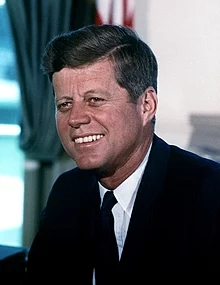 November 22, 1963. President John F. Kennedy was assassinated in Dallas. As explained above, a KGB rogue, Lee Harvey Oswald, fired several shots, while a Mafia expert sniper arranged for by Oswald’s uncle Charles Murret fired the killing shot from the grassy knoll.
November 22, 1963. President John F. Kennedy was assassinated in Dallas. As explained above, a KGB rogue, Lee Harvey Oswald, fired several shots, while a Mafia expert sniper arranged for by Oswald’s uncle Charles Murret fired the killing shot from the grassy knoll.
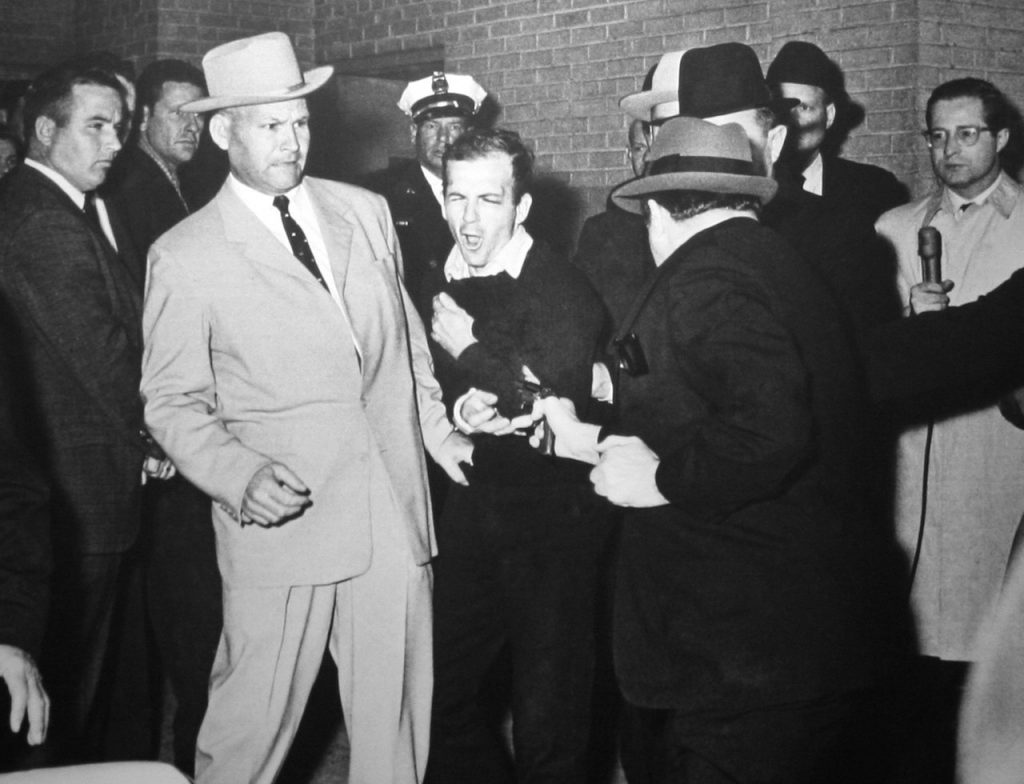 November 24, 1963. Jack Ruby shot to death alleged JFK assassin Lee Harvey Oswald in the basement of the Dallas Police Department headquarters. The Soviets knew of Ruby as a Cuban asset. The KGB wanted Oswald dead so that he wouldn’t talk about his dealings with the Soviets.
November 24, 1963. Jack Ruby shot to death alleged JFK assassin Lee Harvey Oswald in the basement of the Dallas Police Department headquarters. The Soviets knew of Ruby as a Cuban asset. The KGB wanted Oswald dead so that he wouldn’t talk about his dealings with the Soviets.
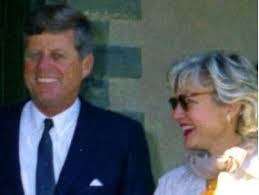 October 12, 1964. A KGB-hired local criminal shot in the head and heart senior JFK consort Mary Meyer on the towpath in Georgetown. This was at the order of Nikita Khrushchev as revenge for her leading Khrushchev to believe that JFK lacked toughness, and thus enticing the Soviet leader into the Cuban Missile Crisis with its humiliating outcome. CIA quickly ascertained that the KGB was responsible for her murder; but CIA remained silent, even though some observers blamed it for her death.
October 12, 1964. A KGB-hired local criminal shot in the head and heart senior JFK consort Mary Meyer on the towpath in Georgetown. This was at the order of Nikita Khrushchev as revenge for her leading Khrushchev to believe that JFK lacked toughness, and thus enticing the Soviet leader into the Cuban Missile Crisis with its humiliating outcome. CIA quickly ascertained that the KGB was responsible for her murder; but CIA remained silent, even though some observers blamed it for her death.
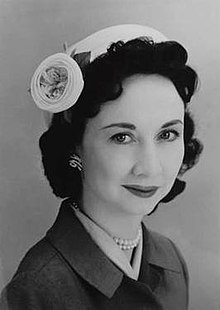 November 8, 1965. Dorothy Kilgallen, renowned columnist and TV celebrity, was found dead at 52 on a bed on the third floor of her townhouse. The autopsy determined that she died from an overdose of ethanol and barbiturates. But many details suggest that she was murdered.44 She never slept in that bed, nor did she wear to bed the outfit she was in. She had on her make-up and false eyelashes, which friends said she would never wear to bed. The autopsy showed that she had taken three different barbiturates, perhaps injected, equivalent to about 5 pills each, too much for an accidental overdose but not in the massive amount that suicides ordinarily use. Just the minimal lethal combination. Lividity markings showed that her body had been moved after death.
November 8, 1965. Dorothy Kilgallen, renowned columnist and TV celebrity, was found dead at 52 on a bed on the third floor of her townhouse. The autopsy determined that she died from an overdose of ethanol and barbiturates. But many details suggest that she was murdered.44 She never slept in that bed, nor did she wear to bed the outfit she was in. She had on her make-up and false eyelashes, which friends said she would never wear to bed. The autopsy showed that she had taken three different barbiturates, perhaps injected, equivalent to about 5 pills each, too much for an accidental overdose but not in the massive amount that suicides ordinarily use. Just the minimal lethal combination. Lividity markings showed that her body had been moved after death.
An outspoken critic of the official lone gunman theory of the JFK assassination, Kilgallen was the only journalist who had interviewed Jack Ruby. She told friends that she had explosive information about the JFK assassination that she was writing up for a book to be published by Random House. She traveled twice to New Orleans to investigate. Researchers who correctly considered her death a murder have generally attributed it to the Mafia or the federal government, eager to suppress damning evidence of a conspiracy to kill Kennedy and then to cover it up. But there is a different, better explanation.
Ruby was a clever, deceptive character who had a compelling reason not to reveal to Kilgallen that the KGB had ordered him to kill Oswald–to avoid the wrath of the KGB. So he presumably told her about Oswald’s encounters with organized crime in New Orleans, the Cuban exiles, CIA plots to kill Castro, etc. in lurid detail. She believed him and was eager to report what she learned from him and from visiting New Orleans. Meanwhile, she had developed a romantic tie with Ron Pataky, a fellow journalist 22 years her junior. Pataky has long been suspected of having a hand in her death.
It appears that the KGB incorrectly but understandably feared that Ruby had told Kilgallen that it had ordered him to kill Oswald. So it inserted Pataky to report on her activities and eventually to collaborate in her murder. One scenario would have him accompany her and let KGB hit men in. They would chloroform her, administer the alcohol and drugs, search her third floor (her husband and children slept upstairs), find her JFK assassination notes, arrange her body and the bedroom, then leave.
Kilgallen had entrusted a copy of her extensive notes on the assassination to her colleague Florence Pritchett, who had long been a girlfriend and confidante of JFK, though she was married to Earl Smith. In August, 1965, Pritchett fell sick and developed leukemia. She died of a cerebral hemorrhage the day after Kilgallen. Her copy of the notes on the JFK assassination disappeared. We may ask whether the KGB had given Pritchett a radioactive poison that caused the leukemia, then stole her copy of the notes upon her death.
There is no direct evidence linking the Mafia or the federal government to Kilgallen’s murder. The KGB had a powerful motive: to murder her and steal her notes on the JFK assassination, especially the ones on Jack Ruby. The theft of her notes, the posited poisoning of Florence Pritchett and theft of her copy of the notes, and the subsequent poisoning of Ruby all point to the KGB.
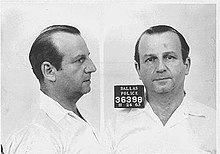 January 3, 1967. Killer of Lee Harvey Oswald Jack Ruby died of virulent lung cancer after receiving in prison a radioactive potion from a KGB asset, according to author and former Romanian intelligence chief Ion Mihai Pacepa.45 A Texas court had overturned Ruby’s death sentence. He would have a new trial, which would likely have led to a short sentence, after which he would walk free and be able to talk with the media. Pacepa’s conjecture relies on an analogy with his account of other such KGB poisonings and thus is not based on direct evidence. Nonetheless, the timing, method, and disease fit. It makes more sense than any other explanation of Ruby’s demise.
January 3, 1967. Killer of Lee Harvey Oswald Jack Ruby died of virulent lung cancer after receiving in prison a radioactive potion from a KGB asset, according to author and former Romanian intelligence chief Ion Mihai Pacepa.45 A Texas court had overturned Ruby’s death sentence. He would have a new trial, which would likely have led to a short sentence, after which he would walk free and be able to talk with the media. Pacepa’s conjecture relies on an analogy with his account of other such KGB poisonings and thus is not based on direct evidence. Nonetheless, the timing, method, and disease fit. It makes more sense than any other explanation of Ruby’s demise.
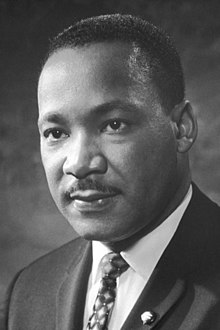 April 4, 1968. Renowned civil rights leader Martin Luther King was killed by a single bullet as he stood on the second floor balcony outside his hotel room in Memphis.46 The shot came from high on his right, not with a horizontal trajectory from the rooming house of the alleged assassin, James Earl Ray, behind the hotel. Ray, not a skilled rifleman, would have needed to stand on the edge of the common bathroom tub to see out the window, and a wall (since conveniently removed) would have kept him from aligning the rifle. Ballistics, forensics, and medical evidence all rule him out. The House Select Committee on Assassinations concluded that there had been a conspiracy, with Ray as the patsy.
April 4, 1968. Renowned civil rights leader Martin Luther King was killed by a single bullet as he stood on the second floor balcony outside his hotel room in Memphis.46 The shot came from high on his right, not with a horizontal trajectory from the rooming house of the alleged assassin, James Earl Ray, behind the hotel. Ray, not a skilled rifleman, would have needed to stand on the edge of the common bathroom tub to see out the window, and a wall (since conveniently removed) would have kept him from aligning the rifle. Ballistics, forensics, and medical evidence all rule him out. The House Select Committee on Assassinations concluded that there had been a conspiracy, with Ray as the patsy.
Critical researchers have argued that the federal government, in particular FBI or CIA, carried out the assassination in order to remove a perceived dangerous critic of racial injustice and the Vietnam War. FBI Director J. Edgar Hoover had publicly denounced MLK, and the Bureau had surveilled and harassed him. CIA and defense agencies also collected intelligence on him. In contrast, all serious researchers scoff at the notion that Ray sought a $50,000 reward supposedly offered by a racist cabal in St. Louis. The King family specifically exonerated Ray and pointed at the FBI.
There is a much more believable suspect, and several observers47 have suggested it: the KGB.
Many Reasons to Murder King
In his book on the assassination of King, leading researcher Philip Melanson argued that the conspiracy to assassinate King was characteristic of individuals from an intelligence agency, i.e., not of a law enforcement agency like FBI48. In particular, the extraordinary story of Ray’s aliases led him to suspect the CIA or CIA rogues. Although Melanson did not explain why he ruled out the KGB, we can surmise that the misleading messages from hard-to-pin-down government sources in Washington, D.C. to the Memphis police in the run-up to the assassination caused him to suspect U.S. agencies, not the Soviets. These messages distracted the Memphis police and led them to focus on a nonexistent threat to an African-American police detective. But we can see that a KGB asset in FBI or on a congressional staff could readily have originated the messages. Meanwhile, for poorly explained reasons, the MPD pulled patrolling police units away from MLK’s hotel, thus facilitating the escape of the shooter. Agents and informers from FBI and CIA were in Memphis, and the MPD intelligence unit was in close contact with FBI in Washington. Thus there were understandable, albeit mistaken, reasons for Melanson and other researchers to suspect a federal government conspiracy.
So, too, there is a simple explanation of how the KGB could have obtained the security file of Ray’s main alias, Eric S. Galt, a Canadian warehouse supervisor working on Union Carbide research on proximity fuses in Toronto: the KGB had an asset in the Royal Canadian Mounted Police, which maintained a security file on Galt. Melanson assumed that the CIA had obtained access to his file via Union Carbide or the RCMP. But trying to place an asset in, or cultivate assets in, the FBI, CIA, and RCMP was an important part of the KGB’s business. We must assume that at times they were successful. This could even happen at a high level. In the 1930s, Congressman Samuel Dickstein, D-NY was on the KGB payroll.49 Thus much of the evidence Melanson and other researchers found that pointed to CIA actually pointed to the KGB as well, and in a more fitting way in regard to motivation. There were many motives for the KGB to assassinate King, but just a few motives for CIA as well as the major disincentives of flagrantly violating CIA’s mission and risking devastating public exposure.
King had relationships with American communists, and some of his entourage were communist sympathizers. Attorney and entrepreneur Stanley D. Levison served King and the Southern Christian Leadership Conference as a key adviser, writer, and fundraiser. According to a KGB document, Levison was a secret member of the Communist Party of the USA.50 King evidently sought good relations with the Soviets. According to an unnamed retired CIA senior official, the KGB invited King to Toronto where, secretly filmed by the RCMP and CIA, a KGB officer handed King an envelope with a lot of cash in it.51 Whether this anecdote is accurate or not, there is no sign that King followed the Kremlin’s line. Even though he spoke out against racial injustice and the Vietnam War, he espoused a view that African-Americans should aspire to the freedoms that America offered. Over time, the KGB lost confidence in him and launched a propaganda campaign to undermine him.
Meanwhile, the extraordinary story of Ray’s aliases52 better matches the KGB. As a petty criminal, Ray had used many aliases–all of them of family and friends, to make them easy to remember. But after escaping from prison in 1967 and finding his way to Montreal, Ray began to use the name Eric Starvo Galt, later shortened to Eric S. Galt, parallel to how the real Galt had shortened his name. Later he would use the names of three other Canadians. All, including Galt, lived in a single suburb of Toronto. In two cases, Ray used the aliases before he had ever been in Toronto, where he arrived after the assassination. In addition, three of the four men bore some physical resemblance to Ray and to each other. And when Eric S. Galt had surgery to shorten his pointed nose, Ray also had surgery in California to shorten his pointed nose! In other words, the preparation of the aliases was mind-bendingly meticulous. Ray also used the Galt alias to obtain an Alabama driver’s license and other documentation. The CIA could have arranged all this, but it seems very odd for CIA to do it in Toronto instead of the U.S. and downright difficult for FBI to do it there since FBI required special permission to operate in Canada. In contrast, it made perfect sense for the KGB to provide these aliases for Ray in Canada, where it faced less surveillance than in the U.S., using its procedures for devising Canadian false identities. As Canada’s leading city, Toronto played a role roughly parallel to Mexico City for the KGB: a metropolis from which it could orchestrate operations throughout a neighbor of the US and in the US as well.
The KGB’s powerful motives and Ray’s intricate, intelligence-linked Canadian aliases make it a much more plausible organizer of the assassination than CIA or FBI, both of which had major disincentives, or than a racist cabal or solo gunman. The many months of readying Ray as a highly characteristic KGB patsy would also be consistent with the painstaking efforts the KGB made to prepare patsies like Lee Harvey Oswald and Sirhan Sirhan.
Therefore, we have many reasons to think that the KGB murdered MLK:
1. It had many compelling reasons to assassinate him.
- To heighten racial antagonisms in the U.S.
- To set off riots.
- To remove a moderate African-American leader who did not do the Soviets’ bidding, thereby opening the door to radical leaders.
- To cast suspicion on FBI.
- In keeping with the JFK assassination, to induce the federal government to cover up any conspiracy. The media would predictably fall in line, thereby undermining public trust in the government and media.
- To demoralize Americans and diminish support for democracy.
In sharp contrast to other suspects, the KGB had no major disincentives.
2. CIA and FBI would have flagrantly violated their charters to protect the American people if they murdered MLK. Some dissident officer was very apt to report them, and it would lead to humiliating public condemnation, punishment of the perpetrators, and possible disbandment of the agencies.
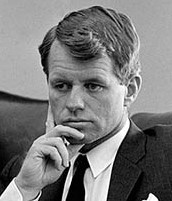 June 8, 1968. Running for the Democratic nomination, Robert F. Kennedy was assassinated in the crowded “pantry” (actually, a food preparation area) of the Ambassador Hotel in Los Angeles after his primary election victory.53 His alleged killer, 24-year old Palestinian-American Sirhan Bishara Sirhan, never got close to Kennedy. He fired shots that hit five bystanders as Kennedy supporters struggled to subdue him; but none of his shots hit Kennedy. The fatal shot behind Kennedy’s ear came from just 1-3 inches away, according to Thomas Noguchi MD, who performed the autopsy. The shooter was apparently right wing security guard Thane Eugene Cesar, who had gripped Kennedy’s arm as they walked through the crowd.
June 8, 1968. Running for the Democratic nomination, Robert F. Kennedy was assassinated in the crowded “pantry” (actually, a food preparation area) of the Ambassador Hotel in Los Angeles after his primary election victory.53 His alleged killer, 24-year old Palestinian-American Sirhan Bishara Sirhan, never got close to Kennedy. He fired shots that hit five bystanders as Kennedy supporters struggled to subdue him; but none of his shots hit Kennedy. The fatal shot behind Kennedy’s ear came from just 1-3 inches away, according to Thomas Noguchi MD, who performed the autopsy. The shooter was apparently right wing security guard Thane Eugene Cesar, who had gripped Kennedy’s arm as they walked through the crowd.
Sirhan Sirhan was found guilty of murder in the first degree and condemned to death, but this was changed to life imprisonment with a possibility of parole. Well before the assassination, a throw from a horse had caused him brain damage. Treatment by at least eight medical doctors had failed to stop his pain. In the process he showed himself extremely easy to hypnotize. Sirhan’s notebooks and his trance-like behavior during the shooting suggest that programming with post-hypnotic suggestion to murder Kennedy, but also to forget who had programmed him or why (he had imbibed several Tom Collinses as well) .
The Los Angeles Police Department insisted from the outset that Sirhan was a lone gunman, despite a daunting array of evidence and testimony to the contrary. The LAPD refused to follow leads, ignored key witnesses, bullied witnesses into changing their stories, changed other stories without consent, destroyed evidence of more bullets than the eight in Sirhan’s handgun, and destroyed some 2400 photos. Sirhan’s lawyer performed in a thoroughly incompetent manner. Both prosecution and defense psychiatrists sought to inculcate in Sirhan under hypnosis their views of the case. The media did not seriously challenge the official story. Years later, questions raised by outraged witnesses and independent researchers led to calls for reinvestigation.
The interest shown by CIA counterintelligence chief James Angleton in the case and various allusions to national security have led some observers to suspect that CIA arranged the assassination. Three CIA officers were at the hotel at the time of the assassination. The eerie resemblance of a seemingly hypnotically programmed Sirhan to a Manchurian candidate assassin added to suspicion of CIA, especially as its MKULTRA mind control program became public knowledge. But we will see reasons to doubt that CIA was behind the murder. Meanwhile, some observers have thought that the Mafia sought to eliminate Robert Kennedy lest he be elected president and renew his campaign as attorney general against organized crime. Yet the Mafia had experienced much turmoil in the aftermath to the JFK assassination, so it would have been reluctant to take on a second such venture. Also, there is no direct or circumstantial evidence other than the Mafia’s aversion to RFK.
The KGB makes a much more persuasive organizer of the assassination.
What motives did the KGB have?
- To complete its revenge against the Kennedys for the Cuban Missile Crisis.
- To keep a popular, tough RFK from becoming president.
- To cast suspicion on CIA.
- To alienate Americans from their government and media.
- To demoralize Americans and undermine support for democracy in an election year.
The KGB was experimenting with mind control and undoubtedly had a keen interest in CIA’s research on hypnotism; but it did not have the same constraints or the same degree of fear of exposure as CIA. It appears that the Palestinian Mahmoud Hamshari had obtained protection money for Olympic Airways (now Olympic Airlines) from Aristotle Onassis. He headed to Los Angeles with the idea of killing a prominent American. An assistant to Onassis referred him for his headaches from Los Angeles smog to renowned hypnotist William Bryan MD in LA.54 Some hypnotherapist with KGB ties seems to have programmed Sirhan. Various Palestinian-Americans were eager to murder Kennedy for having approved the sale of 50 Phantom jets to Israel. Sirhan had anti-Israel views. The KGB brought the left-leaning Palestinian-Americans together with right wing haters of Kennedy such as Thane Eugene Cesar and Michael Wayne (Wien), who acted as a distractor and facilitator at the hotel. The role of middleman and orchestrator fit the KGB better than CIA or FBI in regard to interacting with the Palestinians.
Bryan had worked as a consultant to CIA’s MKULTRA project. An alleged heart attack caused his subsequent death at 50 in a Las Vegas hotel room. But it is possible that the KGB kidnapped him, interrogated him about his hypnotic lore and the MKULTRA project, and murdered him with an injection that caused a heart attack.
Years later, when James Angleton stepped down as head of counterintelligence at CIA, his successor found special files in his office on the assassinations of JFK and RFK, including autopsy photos of RFK’s naked corpse.55 Angleton’s possession of these photos seemed bizarre to him, so he ordered them destroyed. But the photos could have contained evidence that KGB-hired assassins behind Kennedy inflicted his wounds. So it was definitely appropriate for Angleton as chief of the Counterintelligence Staff to have them. Angleton evidently suspected the KGB of the assassinations of both JFK and RFK.
Meanwhile, the programming of Sirhan was highly consistent with the KGB’s interest in mind-control methods. Only CIA had a similar deep interest, yet CIA had major disincentives to murdering RFK. Assassinating him would violate its mission and have a high risk of exposure, with serious consequences for CIA. Thus the evident programming of Sirhan made the KGB the leading suspect. The three CIA officers at the hotel might have had intelligence of a KGB plot against RFK and come to try to stymie it or at least witness the outcome.
Therefore, the KGB emerges as much more likely than CIA, the FBI, the Mafia, the Palestinians (but they played roles, including Sirhan and perhaps his handler), and others to have organized the assassination of RFK.
 March 29, 1977. Soviet spy George de Mohrenschildt died one day before he was to testify to the House Select Committee on Assassinations. Pacepa’s book clearly identifies him as KGB56 handler of Lee Harvey Oswald, after de Mohrenschildt’s assiduous cultivation of his cover as a CIA asset, which fooled many contemporaries and later researchers. Erased from published KGB post-Cold War documentation, de Mohrenschildt had tried to exculpate Oswald and spread misleading information on the JFK assassination. Nonetheless, the KGB evidently sought to eliminate him because he knew too much that was sensitive.57 A certain Charles Mendoza MD, new to Dallas, treated him for bronchitis with injections that caused swift deterioration of mental stability, leading to electroshock treatments. When de Mohrenschildt stopped going to Dr. Mendoza, Mendoza left Dallas, leaving a false forwarding address. de Mohrenschildt claimed that suspicious men were surveilling him and menacing him. Scheduled to be interviewed the next day by the HSCA, de Mohrenschildt was involved in an interview in Florida with researcher Edward Jay Epstein. Coming back to his daughter’s residence for lunch, he was sitting alone in a back room when a gunshot sounded. de Mohrenschildt seemed to have shot himself. While a coroner’s inquest ruled that he had committed suicide with his shotgun, the audio tape of a TV program that the maid was making for his daughter contained a security alarm signal indicating that someone had entered through the back door. There was a little noise, then silence, then beep-beep-beep-beep-beep, then more noise, then a shotgun blast. The tape recording posted on the Internet has since been removed.58
March 29, 1977. Soviet spy George de Mohrenschildt died one day before he was to testify to the House Select Committee on Assassinations. Pacepa’s book clearly identifies him as KGB56 handler of Lee Harvey Oswald, after de Mohrenschildt’s assiduous cultivation of his cover as a CIA asset, which fooled many contemporaries and later researchers. Erased from published KGB post-Cold War documentation, de Mohrenschildt had tried to exculpate Oswald and spread misleading information on the JFK assassination. Nonetheless, the KGB evidently sought to eliminate him because he knew too much that was sensitive.57 A certain Charles Mendoza MD, new to Dallas, treated him for bronchitis with injections that caused swift deterioration of mental stability, leading to electroshock treatments. When de Mohrenschildt stopped going to Dr. Mendoza, Mendoza left Dallas, leaving a false forwarding address. de Mohrenschildt claimed that suspicious men were surveilling him and menacing him. Scheduled to be interviewed the next day by the HSCA, de Mohrenschildt was involved in an interview in Florida with researcher Edward Jay Epstein. Coming back to his daughter’s residence for lunch, he was sitting alone in a back room when a gunshot sounded. de Mohrenschildt seemed to have shot himself. While a coroner’s inquest ruled that he had committed suicide with his shotgun, the audio tape of a TV program that the maid was making for his daughter contained a security alarm signal indicating that someone had entered through the back door. There was a little noise, then silence, then beep-beep-beep-beep-beep, then more noise, then a shotgun blast. The tape recording posted on the Internet has since been removed.58
Allegedly, he died by suicide. Some blamed CIA. But a better explanation is that the KGB feared that de Mohrenschildt would spill the beans about the KGB and JFK to the HSCA. When the KGB’s attempt to destroy his mind and perhaps kill him with Dr. Mendoza’s injections failed, it ordered him murdered.
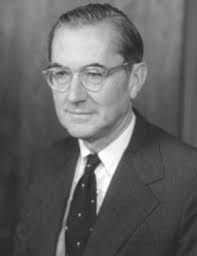 April 27, 1996. William Colby, 76-year old former director of the CIA, disappeared from his vacation home on the water at Rocky Point, Maryland, setting off a full-scale search.59 Eight days later his corpse was found face-down on a nearby shoreline. The medical examiner’s autopsy60 concluded that atherosclerotic disease had caused Colby to fall into the water from his canoe. He died of drowning and hypothermia. The body was described as “in an advanced state of decomposition” after nine days in the water.
April 27, 1996. William Colby, 76-year old former director of the CIA, disappeared from his vacation home on the water at Rocky Point, Maryland, setting off a full-scale search.59 Eight days later his corpse was found face-down on a nearby shoreline. The medical examiner’s autopsy60 concluded that atherosclerotic disease had caused Colby to fall into the water from his canoe. He died of drowning and hypothermia. The body was described as “in an advanced state of decomposition” after nine days in the water.
But that was a lie. The previous day the medical examiner had remarked to journalist Zalin Grant that Colby’s body looked “remarkably well”. A former US Army intelligence officer in Vietnam, where he had worked with Colby, Grant had seen plenty of decomposed bodies. According to the photos of the corpse that he saw, Colby’s body was indeed in very good shape, as if it had spent only a brief time in the water. Colby’s wife said that he was in very good health. He had no history of heart problems. So the report’s “atherosclerotic disease” was also a lie. At any rate, it seemed strange for Colby to take a canoe ride in reported choppy water, after dark, and after he had told his wife, phoning from Texas, that he was tired and would go to bed after supper.
Grant concluded that Colby had been abducted, then murdered by ex-CIA officers who were retaliating against Colby for firing them and disclosing Agency secrets during his time as director, 1973-1976. While Grant’s account of the many discrepancies between the evidence and the official story should lead us to conclude that Colby was indeed murdered, ascribing this to embittered ex-CIA officers seems very open to question. Why would they wait 20 years after his retirement? Some had passed away in the interim, and others were much less fit for an operation like this. Also, would they trust each other not to blab? Why risk arrest and punishment? Besides, a murder seems extreme. Or, if they wanted to murder him, why didn’t they do it right away instead of kidnapping him?
In fact, there is a much more likely perpetrator: a hit squad from a KGB successor agency.61 Why should we think this? First, it far better explains the 9-day interval before the body showed up. That would give the Russians ample time to interrogate Colby in depth. Second, even though 20 years had passed since he had left CIA, Colby possessed exceptional insider knowledge of CIA operations, including of many episodes of the Cold War that the Russians would have wanted to understand. He would also know of CIA operations in the Soviet Union and of Soviet traitors. Third, Colby had remained active as a consultant and Washington commentator. He had contacts throughout the American foreign policy elite and was likely privy to more recent secrets. Fourth, quite aside from Colby’s intelligence value, interrogating and murdering him could exact revenge for his decades of very effectively fighting Soviet communism as well as for the defeat of the Soviet Union in the Cold War.
Why wait until 1996? The KGB might have had Colby on their hit list for many years, but the disruption of the collapse of the Soviet Bloc had led to delays. It might have taken time to persuade President Yeltsin to authorize the kidnapping, assuming that it wasn’t a rogue operation. They also could have viewed this late murder as a reminder to themselves, and perhaps to others, that the Cold War had never completely ended and that the KGB never forgets.
Supporting this interpretation is the very suspicious 1978 death of CIA consultant Arthur Paisley, a retired Agency expert on counterintelligence and verification of nuclear weapons agreements.62 Paisley’s sloop was found run aground on Chesapeake Bay. Seven days later his body was found floating in spite of being weighted down with a diving belt, with a gunshot wound in the back of his head. CIA suggested that his death was by suicide; the Maryland State Police said he died of indeterminate causes. The circumstances, including the number of days available for an interrogation, suggest murder by the KGB. That gives Colby’s kidnapping, interrogation, and murder a clear precedent.
*****
3. Why Have These Cases Remained Unresolved?
Many factors have contributed to the failure to resolve the JFK assassination and other cases in a satisfactory way over the past 60 years. Suspecting the Soviets and fearing war with the USSR, Lyndon Baines Johnson ordered the suppression of any indication that a conspiracy had led to the assassination of JFK. Curiously, therefore, the first conspiracy theory was held by LBJ and senior US officials, though hidden from the public: that the Soviets were behind the assassination. Instead, the blame was pinned on a solo gunman, Lee Harvey Oswald.
After LBJ’s decision, the federal government refused to consider the possibility of conspiracy in any other suspicious death, because then the public would begin to question the conclusion of the Warren Commission that there had been no conspiracy in the JFK assassination. With few exceptions, the media sided with the government until reinvestigations like the House Select Committee on Assassinations in 1979, which criticized the Warren Report and stated that JFK was the victim of a conspiracy. Over time the public, which had largely accepted the Warren Report, swung toward skepticism of the government and media, which has persisted up to the present.
The proliferation of conspiracy theories regarding the JFK assassination led in turn to debunking by writers like Vincent Bugliosi and Gerald Posner. We can see that, since there’s only one correct explanation, all other theories must be wrong; so any debunker is likely to be almost always right. But they incorrectly debunked the right explanation along with the others and ended up supporting the lone gunman error. Thus the debate over the JFK assassination (and over the MLK and RFK ones also) tended to center on whether there was a sole perpetrator or a conspiracy, rather than on which of the suspects was behind the murder. In other cases, despite evidence of foul play, the death was quickly ruled to be an accident or suicide, so that the debate focused on whether it in fact had been a murder, not on who perpetrated it.
J. Edgar Hoover’s FBI became a big proponent of sole perpetrator explanations, at times covering up its own mistakes. Apparently following orders from the federal government, local police forces, e.g., the Los Angeles Police Department in the RFK case, ignored witnesses supporting a conspiracy theory, impugning their credibility and changing their testimony. They also destroyed or lost material evidence. The CIA, for its part, never revealed what it knew about the murders, even though it became a leading suspect in various cases and suffered undeserved damage to its reputation. Clearly, the CIA was eager to protect its sources and, we may surmise, to mislead the KGB into thinking that the CIA did not know that the KGB was the perpetrator. It is possible that CIA investigations correctly determined that the KGB was behind many or all of these murders.
Other factors as well complicated the proper investigation of the ten cases. Before the main assassinations, the KGB circulated misleading rumors and devised ways to cast suspicion on others. Facilitating this was the KGB’s penchant for intruding into fraught situations where domestic American actors were already at odds. In addition, of course, lies and misleading statements by various individuals greatly confused everything. As for Oswald, Ruby, and de Mohrenschildt, these three had been playing both sides of the story for years in an effort to obscure their real agendas.
Outside investigators developed assassination theories, but these theories failed to converge over time. As with the 2001 anthrax mailings case, foreign suspects, aside from Castro’s Cuba, attracted less and less attention while favorite domestic targets such as CIA drew more. When KGB documents leaked out after the Cold War, they contained no mention of any involvement in these ten murders, nor did they even mention de Mohrenschildt, a leading KGB operative. It is possible that KGB defectors revealed operations and personnel to CIA. But CIA kept its mouth shut, as did any former KGB operatives involved in or knowledgeable about the murders.
Thus we should not be surprised that many decades have passed, yet no consensus has emerged about who perpetrated any of the ten murders. Long after the end of the Cold War, many Americans remain alienated from their government and media (there are, of course, other reasons as well), while reputations–notably of Robert Kennedy, Marilyn Monroe, and Dorothy Kilgallen–have been wrongly besmirched.
Instead of focusing on whether they were murders, suicides, accidents, or natural deaths, our approach assumes that they were murders, as so much evidence suggests. Instead of debating whether they were carried out as solo acts or conspiracies, we assume that they were conspiracies, as so much evidence suggests. Our method is to shortlist the main suspects, then compare the merits of the cases against them. Crucially, our short lists include the KGB, so often very incorrectly ignored. As the intelligence agency of America’s main Cold War adversary, the ruthless KGB had a mission to do harm to the United States.
*****
4. Patterns in the Cases
Comparing these cases can shed light on individual killings, reveal some characteristics of the KGB style, and allow us better to understand and evaluate the theory as a whole. While a full and deep comparative analysis remains a challenge for future researchers, here are some shared features of various cases.
- The JFK, MLK, and RFK assassinations all were preceded by rumors.
- The JFK, MLK, and RFK murders all featured distractions.
- All three included painstaking preparation of patsies–Lee Harvey Oswald, James Earl Ray, and Sirhan Sirhan.
- In all three cases, the target was a liberal leader.
- JFK and RFK were brothers, while murdering them served the same purposes for the Soviets of getting revenge for the humiliation of the Berlin and Cuban Missile Crises and removing a tough, popular young leader.
- The assassinations of JFK, MLK, and RFK demoralized Americans, as did the murder of iconic star Marilyn Monroe.
- The assassinations of JFK, MLK, and RFK were followed by disinformation campaigns that successfully blamed CIA, FBI, and various other groups and individuals, causing ongoing alienation of Americans from government and media.
- In the Monroe and MLK cases, the KGB intruded into fraught situations to murder in a manner calculated to cast suspicion on a target person or organization. In the case of Marilyn Monroe, it exploited the rupture of her relations with the Kennedys and her consequent emotional distress to make it look as if the Kennedys had driven her to commit suicide by overdose–or had ordered her murdered. In the Martin Luther King case, the assassination cast suspicion on FBI, whose director, J. Edgar Hoover, notoriously hated and harassed King.
- The KGB technique of using inappropriate medical treatments to undermine the physical and mental health of the target was shared, it appears, by the Marilyn Monroe and George de Mohrenschildt cases. The very defective medical treatment of Elvis Presley, leading to his death at 42, could fit the same pattern, though there is less evidence in that case.
- The KGB murdered Mary Meyer, Marilyn Monroe, and (it appears) Florence Pritchett Smith, all three romantic partners of JFK.
- The MLK and RFK murders took place just two months apart, in an election year.
- At times, murder was accompanied by collection of intelligence via interrogation or theft, notably in the cases of Marilyn Monroe, Dorothy Kilgallen, and William Colby. If the KGB kidnapped and murdered hypnotist William Joseph Bryan MD, interrogating him regarding CIA’s mind-control program would have been a prime motive.
- In the JFK and RFK cases, the KGB or a KGB rogue brought assassins from different backgrounds together, contenting themselves with arranging the murders, not perpetrating them, and distributing the suspicion on various actors and groups.
- In every case, the KGB had multiple incentives for arranging the murder. Of cardinal importance, it was the only suspect that had no disincentive. The murders were all part of the KGB’s mission. They were very deniable. They were low-risk, high-reward acts.
Thus we can see that, although the KGB sought to vary its approach in order to boost deniability, different cases shared common characteristics. In regard to rumors, distractions, patsies, intrusion into fraught situations, casting blame, and collecting intelligence, these characteristics became reasons why the cases have been so hard to resolve.
No doubt, a range of people wanted to or attempted to kill American leaders during the Cold War era. But the KGB was behind the murders that caused the worst harm to America. On the most important assassination, however, the Mafia did collaborate with a KGB rogue.
*****
5. Conclusion
The KGB’s string of deniable murders included one (JFK’s) that constituted perhaps its greatest victory of the Cold War, ironic in that Khrushchev’s and the KGB’s tawdry revenge motive led to such a triumph. The killing shot was by a Mafia sniper, while Oswald hit him from behind. The assassinations of Martin Luther King and Robert Kennedy robbed Americans of two major leaders while exacerbating racial and political tensions. The other KGB murders caused personal tragedy and added to a sense of chaos and loss. We also do not know how much intelligence the KGB collected from interrogations before murders or from stealing files. Perhaps a good deal.
Why was the KGB so successful? The open society of the United States facilitated the operations and contacts of the KGB. The naive and provincial mindset of many Americans, including members of the elite, permitted KGB operatives like George de Mohrenschildt to practice their craft with impunity. The KGB’s skills, imagination, cunning, and ruthlessness also contributed to its success.
The federal government’s refusal to consider that the murders were the result of conspiracies not only gave the KGB more and more leeway; it also alienated many Americans from the government and media. In particular, CIA’s policy of not commenting, even when it knew that the KGB was the perpetrator and when CIA itself was blamed, made the alienation even worse.
These Cold War era murders form a dismal chapter in American history. We cannot change what happened. But now we can at least come to understand these tragic events; stop blaming innocent people, organizations, and American culture; draw some Lessons Learned; and gain at last a sense of closure.
*****
See also the interview of the writer at https://rumble.com/v3kcnd2-ken-dillon-who-killed-the-kennedys-cia-or-kgb-the-trevor-loudon-report-9.24.html
Kenneth J. Dillon is an historian and former State Department intelligence analyst who writes on history and science. See the biosketch at About Us. See also his novel Rosemarie (Washington, D.C.: Scientia Press, 2021).

